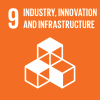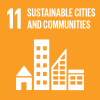Maccaferri
Environmental Thesis
Civil infrastructures are responsible for approximately 5% of global emissions, or approx. 2.5Gt CO2. While heating and cooling are the main responsible for emissions in buildings, building materials are responsible for 50-60% of emissions in infrastructures. As a result also of climate change, registered natural disasters have doubled over the last 40 years. Their dollar impact has grown 10 times and the industry will be required to develop new infrastructures able to resist this growing concern.
The market exhibits continuous growth, driven by several fundamental drivers including the growing share of urban population, the need for new infrastructure in developing markets, the upgrading of existing infrastructure in developed economies, and the increasing impact of climate-related hazards.
Against this backdrop, Maccaferri plays a key role as a truly differentiated Environmental Engineering Solution provider, delivering a comprehensive product offering, which contributes to lowering the environmental footprint by between 30% and 90% compared to industry alternatives.
Based on preliminary estimates, the Group contributes to materials saved equivalent to the weight of approx. 700,000 SUVs and reducing CO2 emissions equivalent to the level of emissions absorbed by approx. 2 million trees.
Business
Founded in 1879 and based in Bologna, Italy, Officine Maccaferri is a provider of Environmental Engineering Solutions and a key market player in the design and development of solutions within the civil engineering, geotechnical and environmental construction market.
The company is synonymous with technical excellence, reliability and environmental sustainability: Maccaferri’s products represent a low carbon emissions and environmentally friendly alternative within the building materials space.
In a market characterised by significant fragmentation, Officine Maccaferri stands out as one of the most respected players and is well-positioned to further grow its business globally.
Environmental Impact
Ambienta only invests in businesses which have a positive impact on the environment through either, or both, a Resource Efficiency or Pollution Control contribution. Our proprietary methodology, the Environmental Impact Analysis, allow us to measure the contribution of different businesses to sustainability in terms of Resource Efficiency and Pollution Control which we capture through 11 Environmental Metrics.
For each portfolio company we report its impact in relation to our metrics.
Resource Efficiency
Maccaferri’s contribution to Resource Efficiency is summarized by the following Environmental Metrics:

Materials Saved
Pollution Control
Maccaferri’s contribution to Pollution Control is summarized by the following Environmental Metrics:

CO2 Emissions Reduced
Sustainable Development Goals
Our Methodology and Metrics are fully aligned with the UN Sustainable Development Goals adopted in 2015. Through our investment scope definition that focuses on products and services that improve Resource Efficiency and Pollution Control we fully capture 10 of the 17 Goals and their respective sub-goals.
For each portfolio company we report its impact in relation to the SDGs.


